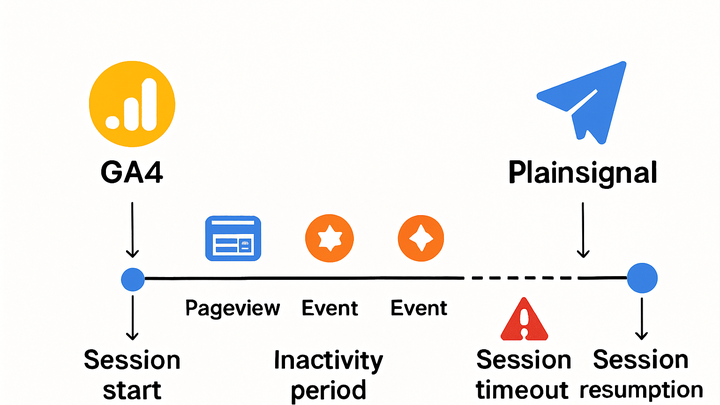Published on 2025-06-27T19:46:16Z
What is a Session? Examples of Sessions in Analytics
In web analytics, a session is a collection of interactions users have on a website within a specific
timeframe. It begins with their first action—loading a page or triggering an event—and ends after a period
of inactivity, typically 30 minutes by default, or at midnight. Sessions are crucial for grouping user
behavior, analyzing engagement, and deriving metrics like bounce rate and session duration. In platforms
like Google Analytics 4 (GA4) and PlainSignal, sessions are tracked differently—GA4 relies on cookies and
events such as session_start, while PlainSignal offers a cookie-free approach using
deterministic fingerprinting to preserve user privacy. Understanding sessions helps analysts configure
accurate tracking, interpret metrics correctly, and optimize user experiences based on visit patterns.
Sessions
A session is a group of user interactions on a website within a set timeframe, key for behavior analysis and engagement metrics.
Definition and Importance
This section explains what a session is in web analytics and why it’s a fundamental metric for understanding user behavior.
-
Session defined
A session represents a group of user interactions with a website or app within a given time frame.
-
Session timeout
Sessions typically end after a period of inactivity, commonly set to 30 minutes by default.
-
Session boundary
A session starts with the first pageview or event and ends when the user is inactive beyond the timeout.
-
-
Importance of sessions
Sessions provide context for user behavior, grouping interactions logically to enable meaningful analysis.
-
Behavior grouping
Sessions help group pageviews, events, and transactions in a coherent user visit.
-
Key metrics
Metrics like bounce rate, session duration, and pages per session rely on accurate session tracking.
-
How Sessions are Tracked
Explores the mechanisms behind session tracking, including cookie-based methods and cookie-free alternatives.
-
Cookie-based tracking
Traditional analytics tools use cookies to assign session IDs and persist user state across pages.
-
First-party cookies
Placed on the user’s browser to maintain session continuity.
-
Limitations
Cookie deletion or blocking can break session continuity.
-
-
Cookie-free tracking
Tools like PlainSignal use deterministic fingerprinting or server-side tracking to track sessions without cookies.
-
Fingerprinting
Uses browser characteristics and IP to maintain session state.
-
Privacy compliance
Reduces reliance on user consent compared to cookie-based approaches.
-
-
Session timeout configuration
Defines the period of inactivity after which a session is considered ended in analytics platforms.
-
Default settings
GA4 defaults to a 30-minute timeout, configurable per property.
-
Custom configuration
Adjust timeouts based on expected user behavior on your site or app.
-
Examples Using SaaS Products
Shows how sessions are tracked in practice with PlainSignal and GA4 configurations.
-
PlainSignal cookie-free session code
Integrate the following PlainSignal snippet to enable session tracking without cookies:
<link rel="preconnect" href="//eu.plainsignal.com/" crossorigin /> <script defer data-do="yourwebsitedomain.com" data-id="0GQV1xmtzQQ" data-api="//eu.plainsignal.com" src="//cdn.plainsignal.com/plainsignal-min.js"></script>-
Data attributes
The
data-idattribute specifies your PlainSignal site ID anddata-dois your domain. -
Session initialization
The script automatically starts a new session when loaded on the page.
-
-
GA4 session tracking setup
Use gtag.js or Google Tag Manager to configure GA4 session tracking, leveraging the
session_startevent.-
Gtag.js implementation
Include your GA4 property ID with
gtag('config', 'G-XXXXXXX');to enable session tracking. -
Session parameters
GA4 triggers a
session_startevent automatically for new sessions, which can be customized in GTM.
-
Best Practices and Considerations
Guidelines to ensure accurate session data and insightful analytics results.
-
Define appropriate timeout
Set session timeouts that reflect user engagement patterns on your site or app.
-
Short sessions
For quick interactions like support chats, consider shorter timeouts.
-
Long sessions
For content-heavy sites, longer timeouts help capture full visits.
-
-
Avoid session inflation
Prevent artificial session inflation caused by auto-refreshes or bot traffic.
-
Bot filtering
Implement bot and crawler filters in your analytics settings.
-
Event deduplication
Ensure repeated events don’t inadvertently start new sessions.
-
-
Cross-device session stitching
Understand how sessions can be linked across devices for a unified user journey.
-
User-id tracking
GA4’s User-ID feature helps unify sessions across logged-in devices.
-
Stitching challenges
Cookie-free methods may struggle to connect sessions across devices without a consistent identifier.
-
